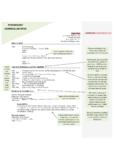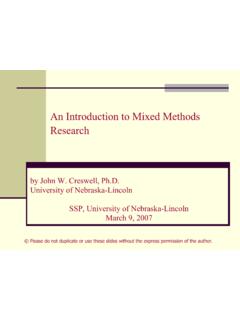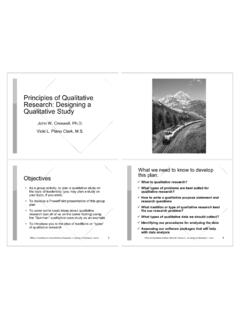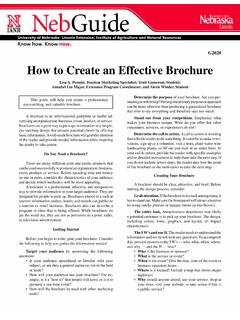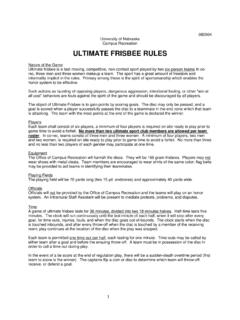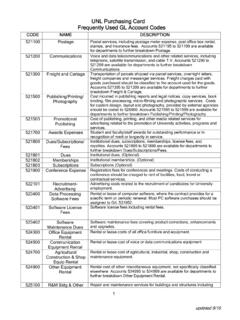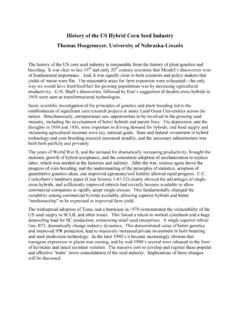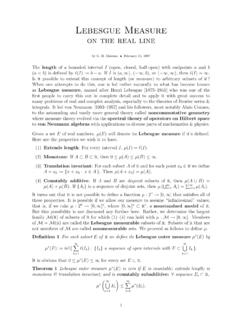Transcription of University of Nebraska, Lincoln - CEIL-CONICET
1 I dedicate this book to Uncle Jim (James W. Marshall, , 1915 1977). who provided love, support, and inspiration. University of nebraska , Lincoln FOR INFORMATION: Copyright 2013 by SAGE Publications, Inc. All rights reserved. No part of this book may be reproduced SAGE Publications, Inc. or utilized in any form or by any means, electronic or 2455 Teller Road mechanical, including photocopying, recording, or by Thousand Oaks, California 91320. any information storage and retrieval system, without permission in writing from the publisher. E-mail: SAGE Publications Ltd. 1 Oliver's Yard Printed in the United States of America 55 City Road London EC1Y 1SP. Library of Congress Cataloging-in-Publication Data United Kingdom Creswell, John W. SAGE Publications India Pvt. Ltd. Qualitative inquiry and research design : choosing among B 1/I 1 Mohan Cooperative Industrial Area five approaches /. Mathura Road, New Delhi 110 044 John W. Creswell. 3rd ed.
2 India p. cm. Previous ed. cataloged as: Qualitative inquiry & research SAGE Publications Asia-Pacific Pte. Ltd. design. c2007. 3 Church Street Includes bibliographical references and index. #10-04 Samsung Hub ISBN 978-1-4129-9531-3 (cloth). Singapore 049483 ISBN 978-1-4129-9530-6 (pbk.). 1. Social sciences Methodology. I. Creswell, John W. Qualitative inquiry & research design. II. Title. 2013. dc23 2011050629. Publisher: Vicki Knight Associate Editor: Lauren Habib Editorial Assistant: Kalie Koscielak Production Editor: Brittany Bauhaus Copy Editor: Melinda Masson Typesetter: C&M Digitals (P) Ltd. Proofreader: Sue Irwin Indexer: Diggs Publication Services, Inc. Cover Designer: Rose Storey This book is printed on acid-free paper. Marketing Manager: Nicole Elliott Permissions Editor: Adele Hutchinson 12 13 14 15 16 10 9 8 7 6 5 4 3 2 1. Brief Contents About the Author xiv Acknowledgments xv Analytic Table of Contents by Approach xvi List of Tables and Figures xx 1.
3 Introduction 1. 2. Philosophical Assumptions and Interpretive Frameworks 15. 3. Designing a Qualitative Study 42. 4. Five Qualitative Approaches to Inquiry 69. 5. Five Different Qualitative Studies 111. 6. Introducing and Focusing the Study 129. 7. Data Collection 145. 8. Data Analysis and Representation 179. 9. Writing a Qualitative Study 213. 10. Standards of Validation and Evaluation 243. 11. Turning the Story and Conclusion 269. Appendix A. An Annotated Glossary of Terms 282. Appendix B. A Narrative Research Study . Living in the Space Between Participant and Researcher as a Narrative Inquirer: Examining Ethnic Identity of Chinese Canadian Students as Conflicting Stories to Live By 303. Elaine Chan Appendix C. A Phenomenological Study Cognitive Representations of AIDS 327. Elizabeth H. Anderson and Margaret Hull Spencer Appendix D. A Grounded Theory Study Developing Long-Term Physical Activity Participation: A Grounded Theory Study with African American Women 347.
4 Amy E. Harley, Janet Buckworth, Mira L. Katz, Sharla K. Willis, Angela Odoms-Young, and Catherine A. Heaney Appendix E. An Ethnography Rethinking Subcultural Resistance: Core Values of the Straight Edge Movement 370. Ross Haenfler Appendix F. A Case Study Campus Response to a Student Gunman 399. Kelly J. Asmussen and John W. Creswell References 417. Author Index 435. Subject Index 442. Detailed Contents About the Author xiv Acknowledgments xv Analytic Table of Contents by Approach xvi List of Tables and Figures xx 1. Introduction 1. Purpose and Rationale for the Book 2. What Is New in This Edition 2. Positioning Myself 6. Selection of the Five Approaches 7. Narrative Research 11. Phenomenology 12. Grounded Theory 12. Ethnography 12. Case Study 12. Audience 12. Organization 13. 2. Philosophical Assumptions and Interpretive Frameworks 15. Questions for Discussion 16. Philosophical Assumptions 16. A Framework for Understanding Assumptions 16.
5 Why Philosophy Is Important 18. Four Philosophical Assumptions 19. Writing Philosophical Assumptions Into Qualitative Studies 22. Interpretive Frameworks 22. Postpositivism 23. Social Constructivism 24. Transformative Frameworks 25. Postmodern Perspectives 27. Pragmatism 28. Feminist Theories 29. Critical Theory and Critical Race Theory (CRT) 30. Queer Theory 32. Disability Theories 33. The Practice of Using Social Justice Interpretive Frameworks in Qualitative Research 34. Linking Philosophy and Interpretive Frameworks 35. Summary 38. Additional Readings 38. Exercises 40. 3. Designing a Qualitative Study 42. Questions for Discussion 43. The Characteristics of Qualitative Research 43. When to Use Qualitative Research 47. What a Qualitative Study Requires From Us 49. The Process of Designing a Qualitative Study 49. Preliminary Considerations 50. Steps in the Process 51. Elements in All Phases of the Research 55. Ethical Issues During All Phases of the Research Process 56.
6 The General Structure of a Plan or Proposal 61. Summary 64. Additional Readings 66. Exercises 67. 4. Five Qualitative Approaches to Inquiry 69. Questions for Discussion 70. Narrative Research 70. Definition and Background 70. Defining Features of Narrative Studies 71. Types of Narratives 72. Procedures for Conducting Narrative Research 73. Challenges 76. Phenomenological Research 76. Definition and Background 76. Defining Features of Phenomenology 78. Types of Phenomenology 79. Procedures for Conducting Phenomenological Research 80. Challenges 82. Grounded Theory Research 83. Definition and Background 83. Defining Features of Grounded Theory 85. Types of Grounded Theory Studies 86. Procedures for Conducting Grounded Theory Research 88. Challenges 89. Ethnographic Research 90. Definition and Background 90. Defining Features of Ethnographies 91. Types of Ethnographies 93. Procedures for Conducting an Ethnography 94. Challenges 96. Case Study Research 97.
7 Definition and Background 97. Defining Features of Case Studies 98. Types of Case Studies 99. Procedures for Conducting a Case Study 100. Challenges 101. The Five Approaches Compared 102. Summary 107. Additional Readings 107. Exercises 110. 5. Five Different Qualitative Studies 111. Questions for Discussion 112. A Narrative Study (Chan, 2010; see Appendix B) 112. A Phenomenological Study (Anderson & Spencer, 2002;. see Appendix C) 114. A Grounded Theory Study (Harley et al., 2009;. see Appendix D) 116. An Ethnographic Study (Haenfler, 2004;. see Appendix E) 118. A Case Study (Asmussen & Creswell, 1995;. see Appendix F) 119. Differences Among the Approaches 121. Central Features of Each Approach 121. Selecting Your Approach 123. Summary 124. Additional Readings 125. Exercises 128. 6. Introducing and Focusing the Study 129. Questions for Discussion 130. The Research Problem Statement 130. The Purpose Statement 134. The Research Questions 138.
8 The Central Question 138. Subquestions 140. Summary 142. Additional Readings 143. Exercises 143. 7. Data Collection 145. Questions for Discussion 145. The Data Collection Circle 146. The Site or Individual 147. Access and Rapport 151. Institutional Review Boards 152. Access and Rapport Within the Five Approaches 153. Purposeful Sampling Strategy 154. Participants in the Sample 155. Types of Sampling 156. Sample Size 157. Forms of Data 157. Interviewing 163. Observation 166. Recording Procedures 168. Field Issues 171. Access to the Organization 171. Observations 172. Interviews 172. Documents and Audiovisual Materials 174. Ethical Issues 174. Storing Data 175. Five Approaches Compared 176. Summary 177. Additional Readings 177. Exercises 178. 8. Data Analysis and Representation 179. Questions for Discussion 179. Three Analysis Strategies 180. The Data Analysis Spiral 182. Organizing the Data 182. Reading and Memoing 183. Describing, Classifying, and Interpreting Data Into Codes and Themes 184.
9 Interpreting the Data 187. Representing and Visualizing the Data 187. Analysis Within Approaches to Inquiry 189. Narrative Research Analysis and Representation 189. Phenomenological Analysis and Representation 193. Grounded Theory Analysis and Representation 195. Ethnographic Analysis and Representation 197. Case Study Analysis and Representation 199. Comparing the Five Approaches 200. Computer Use in Qualitative Data Analysis 201. Advantages and Disadvantages 201. A Sampling of Computer Programs 203. Use of Computer Software Programs With the Five Approaches 204. How to Choose Among the Computer Programs 209. Summary 211. Additional Readings 211. Exercises 212. 9. Writing a Qualitative Study 213. Questions for Discussion 213. Several Writing Strategies 214. Reflexivity and Representations in Writing 214. Audience for Our Writings 217. Encoding Our Writings 217. Quotes in Our Writings 219. Overall and Embedded Writing Strategies 220. Narrative Writing Structure 220.
10 Overall Structure 220. Embedded Structure 224. Phenomenological Writing Structure 225. Overall Structure 226. Embedded Structure 228. Grounded Theory Writing Structure 229. Overall Structure 229. Embedded Structure 231. Ethnographic Writing Structure 232. Overall Structure 233. Embedded Structure 234. Case Study Writing Structure 236. Overall Structure 236. Embedded Structure 238. A Comparison of Narrative Structures 239. Summary 240. Additional Readings 240. Exercises 241. 10. Standards of Validation and Evaluation 243. Questions for Discussion 243. Validation and Reliability in Qualitative Research 244. Perspectives on Validation 244. Validation Strategies 250. Reliability Perspectives 253. Evaluation Criteria 255. Qualitative Perspectives 255. Narrative Research 258. Phenomenological Research 259. Grounded Theory Research 260. Ethnographic Research 262. Case Study Research 264. Comparing the Evaluation Standards of the Five Approaches 265.

